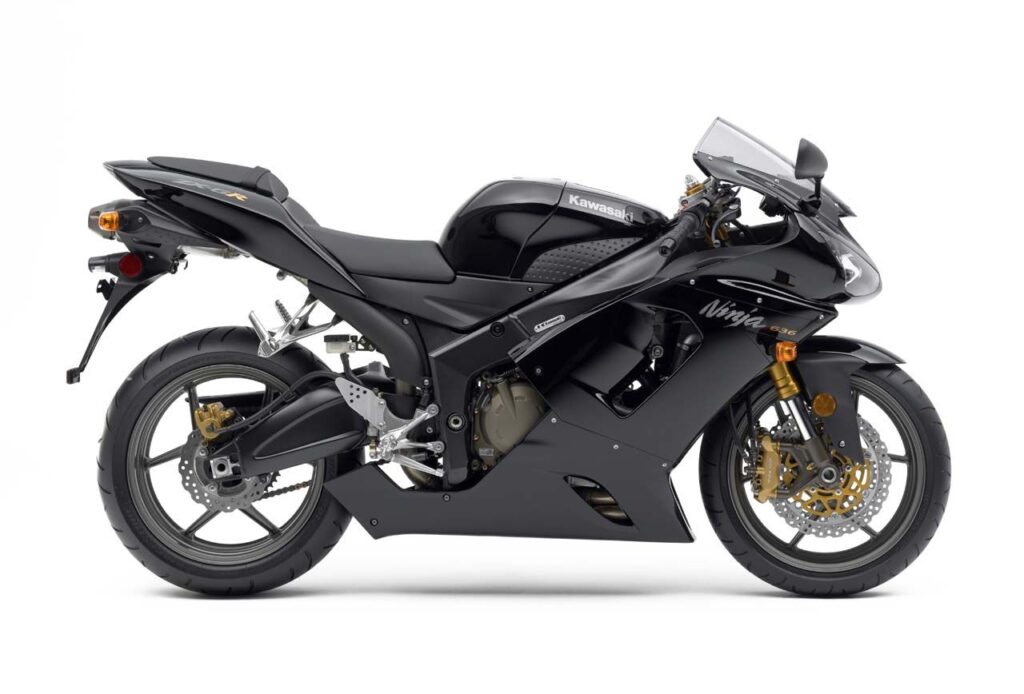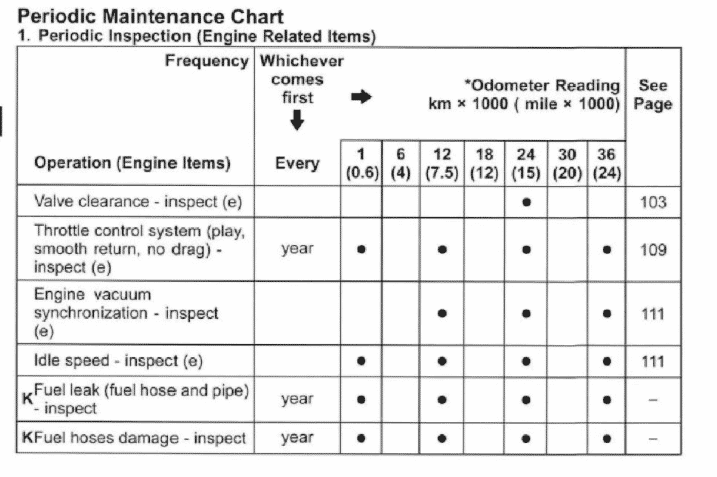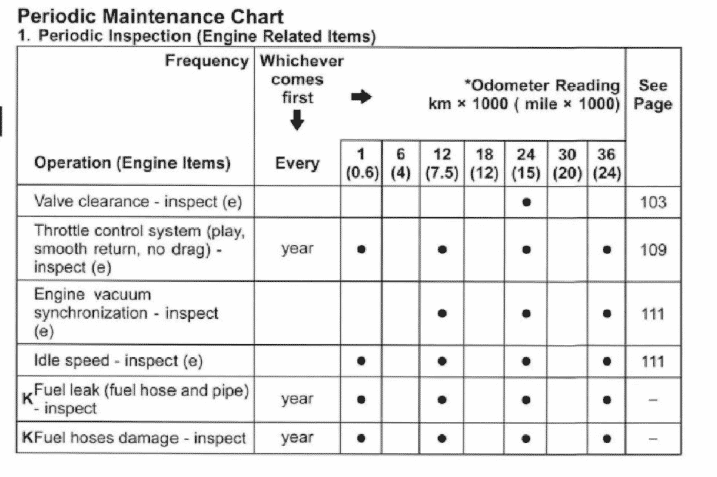Kawasaki Ninja ZX-6R 636 (1st gen, 2003-2006) Maintenance Schedule and Service Intervals
This is the maintenance schedule with associated service intervals for the Kawasaki Ninja ZX-6R 636 made between 2003-2006 (Looking for the later ZX-6R 636 made from 2013 onward?). During that period Kawasaki also made the Kawasaki Ninja ZX-6RR with 599cc, to satisfy racing requirements.
The Kawasaki Ninja ZX-6R was introduced in 1995 and has been constantly updated throughout the years. The year 2003 was the first time Kawasaki used the 636cc “cheater” displacement for their road motorcycles (replacing the earlier 1998-2002 Ninja ZX-6R), gaining a power and mid-range torque advantage over the middleweight supersport rivals. Between 2003 and 2006, Kawasaki kept the engine the same, though a few parts are different (all noted below) with the improvements in the 2005-2006 version.
In 2007 Kawasaki temporarily discontinued the ZX-6R 636, focusing on the 599 version for the years to come.
You might also be interested in:
- 1998-2002: Kawasaki Ninja ZX-6R, a 599cc sport bike
- 2003-2006: Kawasaki Ninja ZX-6R 636, a higher displacement sport bike than earlier generations
- 2003-2006: Kawasaki Ninja ZX-6RR, a 599cc race class motorcycle
- 2007-2012: Kawasaki Ninja ZX-6R, only available in 599cc
- 2013-2023: Kawasaki Ninja ZX-6R 636, second generation with much more rider aids
- 2024+ Kawasaki Ninja ZX-6R 636, with updated breathing, gearing, TFT display, and modified maintenance requirements
Originally published October 24 2020, but significantly revamped since.
This site has links for things like oil and spark plugs from which we earn a commission (which unfortunately nobody can save, not even us). If you appreciate this work, then please use those links. Thanks!
Service Intervals for the Kawasaki ZX-6R 636
The ZX-6R 636 has 7500 mile / 12000 km or annual service intervals between oil changes. At every service, also change the oil filter and spark plugs, and go through a list of inspection items.
Kawasaki has specified a number of items that should be checked every year regardless of mileage, and every distance. They also recommend replacing the rubber hoses periodically, every 2-4 years depending on the part.
The major valve service interval for the ZX-6R 636 is every 15000 miles or 24000 km.
Make sure you keep your coolant fresh and your brake fluid up to date.
Maintenance Schedule for Kawasaki Ninja ZX-6R 636 (2003-2006)
Below is the maintenance schedule for the Kawasaki Ninja ZX-6R 636 (made between 2003 and 2006).
The original maintenance for the Kawasaki Ninja ZX-6R 636 is broken into three sections: Engine Related Items, Chassis Related Items, and Change/Replacement Items.
We’ve combined and simplified it, replacing it with a schedule with these items:
- Regular major maintenance — oil changes, spark plugs, valve service intervals, etc.
- Annual scheduled maintenance — a checklist of things to go over
- Chain maintenance
Notes:
- For higher odometer readings, repeat at the frequency interval established here.
- Brake system — Inspect between services, every 3000 miles / 5000 km
- If riding off road or in rain, inspect / replace engine oil, air filter, chain, and brake pads more often.
Regular major maintenance
| mi x 1000 | 7.5 | 15 | 22.5 | 30 | |
|---|---|---|---|---|---|
| km x 1000 | 12 | 24 | 36 | 48 | Every |
| Standard annual inspection (see below) – Perform | ✓ | ✓ | ✓ | ✓ | year |
| Engine oil — Replace (Motul 7100 10W-40, or another high-grade synthetic 10W-40 that meets JASO MA) | ✓ | ✓ | ✓ | ✓ | year |
| Oil filter – Replace (Hiflofiltro HF204RC) | ✓ | ✓ | ✓ | ✓ | year |
| Air cleaner element – replace * 2003-2004: KA-6003 * 2005-2006: KA-6005 | 12000 mi / 18000 km | ||||
| Spark plug – Replace. Note condition of old plug. (NGK CR9E) | ✓ | ✓ | ✓ | ✓ | |
| Valve clearances – inspect / adjust | ✓ | ✓ | |||
| Engine vacuum synchronization – inspect | ✓ | ✓ | ✓ | ✓ | |
| Air suction system damage – inspect | ✓ | ✓ | ✓ | ✓ | |
| Idle speed – inspect | ✓ | ✓ | ✓ | ✓ | |
| Brake pad wear – inspect | ✓ | ✓ | ✓ | ✓ | |
| Coolant – Replace | ✓ | 3 years | |||
| Radiator hoses and O-rings – Replace | ✓ | 3 years | |||
| Brake fluid (front and rear) – Replace (Castrol DOT 4) | ✓ | ✓ | 2 years | ||
| Brake hoses – Replace | ✓ | 4 years | |||
| Rubber parts of master cylinder and calipers – Replace | ✓ | 4 years | |||
| Steering stem bearings – lubricate | ✓ | ✓ | 2 years | ||
| Fuel hoses – Replace | ✓ | 4 years | |||
| Clutch operation (play, engagement, disengagement) – inspect | ✓ | ✓ | ✓ | ✓ | |
| Drive chain wear – inspect | ✓ | ✓ | ✓ | ✓ | |
| Drive chain guide wear – inspect | ✓ | ✓ | ✓ | ✓ | |
| Wheels/tires damage – inspect | ✓ | ✓ | ✓ | ✓ | |
| Tire tread wear, abnormal wear – inspect | ✓ | ✓ | ✓ | ✓ | |
| Front forks/rear shock absorber operation (damping and smooth stroke) – inspect | ✓ | ✓ | ✓ | ✓ | |
| Uni-trak rocker arm and tie rods operation – inspect | ✓ | ✓ | ✓ | ✓ |
Annual inspection
Below is the annual inspection checklist for the 2003-2006 ZX-6R. Perform it according to the schedule above.
| ZX-6R Annual Inspection Checklist |
|---|
| Throttle control system (play, smooth return, no drag) – inspect |
| Fuel leak (fuel hose and pipe) – inspect |
| Fuel hoses damage – inspect |
| Fuel hoses installation condition – inspect |
| Coolant level – inspect |
| Coolant leak – inspect |
| Radiator hose damage – inspect |
| Radiator hoses installation condition – inspect |
| Tire air pressure – inspect |
| Wheel bearings damage – inspect |
| Brake fluid leak – inspect |
| Brake hoses damage – inspect |
| Brake hose installation condition – inspect |
| Brake fluid level – inspect Inspect more often — Manual recommends 6 months |
| Brake operation (effectiveness, play, drag) – inspect |
| Brake light switch operation – inspect |
| Steering play – inspect |
| Front forks/rear shock absorber oil leak – inspect |
| Lights and switches operation – inspect |
| Headlight aiming – inspect |
| Side stand switch operation – inspect |
| Engine stop switch operation – inspect |
| Evaporative emission control system – function (if fitted) |
| Chassis parts – lubricate |
| Bolts and nuts tightness – inspect |
Maintaining Your Chain on the Kawasaki ZX-6R 636
The manual for the ZX-6R 636 specifies that you should maintain the chain of the 636 according to the following schedule, or more often if you ride aggressively or in difficult conditions, or after washing the motorcycle.
Use a good-quality chain lubricant like Motul chain paste, or a Motul chain care kit to restore the chain.
Kawasaki recommends you follow the following chain maintenance schedule:
| Chain maintenance item | Every |
|---|---|
| Check drive chain lubrication condition, lubricating if necessary (Motul chain paste) | 400 mi / 600 km |
| Check drive chain slack, adjusting if necessary | 600 mi / 1000 km |
Checking chain slack
To measure drive chain slack, measure the free vertical movement of the loosest part of the chain (on the bottom).
Target Chain Slack for the 2003-2004 ZX-6R 636: 25-30 mm (1.0-1.2 in)
Target Chain Slack for the 2005-2006 ZX-6R 636: 30-35 mm (1.2-1.4 in)
If the chain is too loose (or too tight), adjust it via the following procedure.
Adjusting chain slack
To adjust chain slack, put the motorcycle in neutral and put it on its kickstand on a level surface.
You need:
- A large wrench and/or breaker bar for the rear axle
- A large torque wrench for the rear axle
- Wrenches for other parts

- Loosen the two locknuts at the rear that hold the chain tension adjustment bolts in place.
- Remove the cotter pin from the rear axle. Loosen the rear axle (no need to remove it). It can be (and should be) quite tight — you might need a breaker bar or a large wrench.
- Use a small wrench to adjust the tension on the chain. Change by the same amount on both sides of the axle, and keep measuring slack until the target amount is achieved.
Tyre size and tyre pressure for the Kawasaki Ninja ZX-6R 636
The ZX06R 636, being a sport bike, originally shipped with sport tires. But you can fit anything from the full road sport, to sport touring (a happy medium), to road tires for mileage.
Here are the standard tire sizes and pressures.
| Wheel | Tire size | Tire pressure (cold) |
|---|---|---|
| Front | 120/65ZR17 M/C (56 W) | 250 kPa / 2.5 bar / 36 psi |
| Rear | 180/55ZR17 M/C (73 W) | 290 kPa / 2.9 bar / 42 psi |
Of course, use those tire pressures as a template and modify them to suit your riding style.
About the Kawasaki Ninja ZX-6R 636 (2003-2006)

Since its launch in 1995, the Kawasaki Ninja ZX-6R 636 had already made a name for itself, and helped usher in a new phase of more focused sport bikes (like the YZF-R6). Prior to this phase, manufacturers were trying to make motorcycles that could do it all.
Kawasaki had built the ZX-6R as a 599-cc model since 1995, but in late 2002 (with an early carburettor-fed version) had experimented with a 636-cc displacement ZX-6R for street use. In 2003, Kawasaki formalised this with the fuel-injected 2003 ZX-6R 636.

Expanding to 636cc was an unusual move for Kawasaki, but one that let it get a power and mid-range torque advantage over its rivals. For street riders for whom complying with a 600cc maximum wasn’t a critical requirement, this was a win.
Kawasaki also gave the 2003 ZX-6R 636 an inverted fork and radially-mounted brake calipers. Both of those features are now widely seen on motorcycles, even in the mid-tier class.
Kawasaki continued to improve on the ZX-6R 636 in 2005. They kept the same basic engine, but gave it ram air and a more aggressive tune, increasing peak power to 130 hp at 14000 rpm, or a whopping 136 hp with ram air.

For the 2005 Kawasaki ZX-6R, Kawasaki gave it ram air induction, petal-style discs, and an under-seat exhaust. The 2005-2006 ZX-6R also got a slipper clutch, a feature only previously available on the 2003-2004 ZX-6RR.
For the 2006 model year, Kawasaki has also added a ZX-6R “Special Edition” model with titanium silver paint and a different wheel finish. Aside from the paint scheme, the bike is largely the same.
The 2003-2006 Kawasaki ZX-6R series is a street sport bike that’s an underdog in terms of desirability, with the CBR and R6 (and even the Gixxer) taking all the glory, but not in terms of performance or even style. It just hasn’t had the same branding and marketing dollars poured into it.
During this period, Kawasaki also made a 599-cc class motorcycle, the 2003-2006 Kawasaki ZX-6RR, which shares the same aesthetic (year for year) and most components, but has a smaller and peakier engine.
Manual for the Kawasaki Ninja ZX-6R 636
The above maintenance schedule comes directly from the user’s manual for the 2003-2006 Kawasaki Ninja ZX-6R, checking between model years for changes. You can see from these screenshots that they share the same schedule.
You can view the original manuals here.













